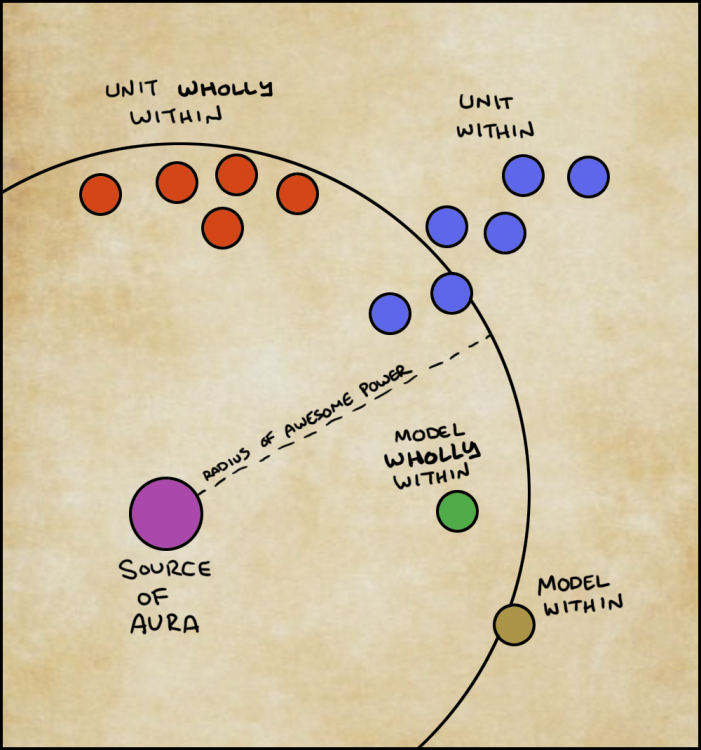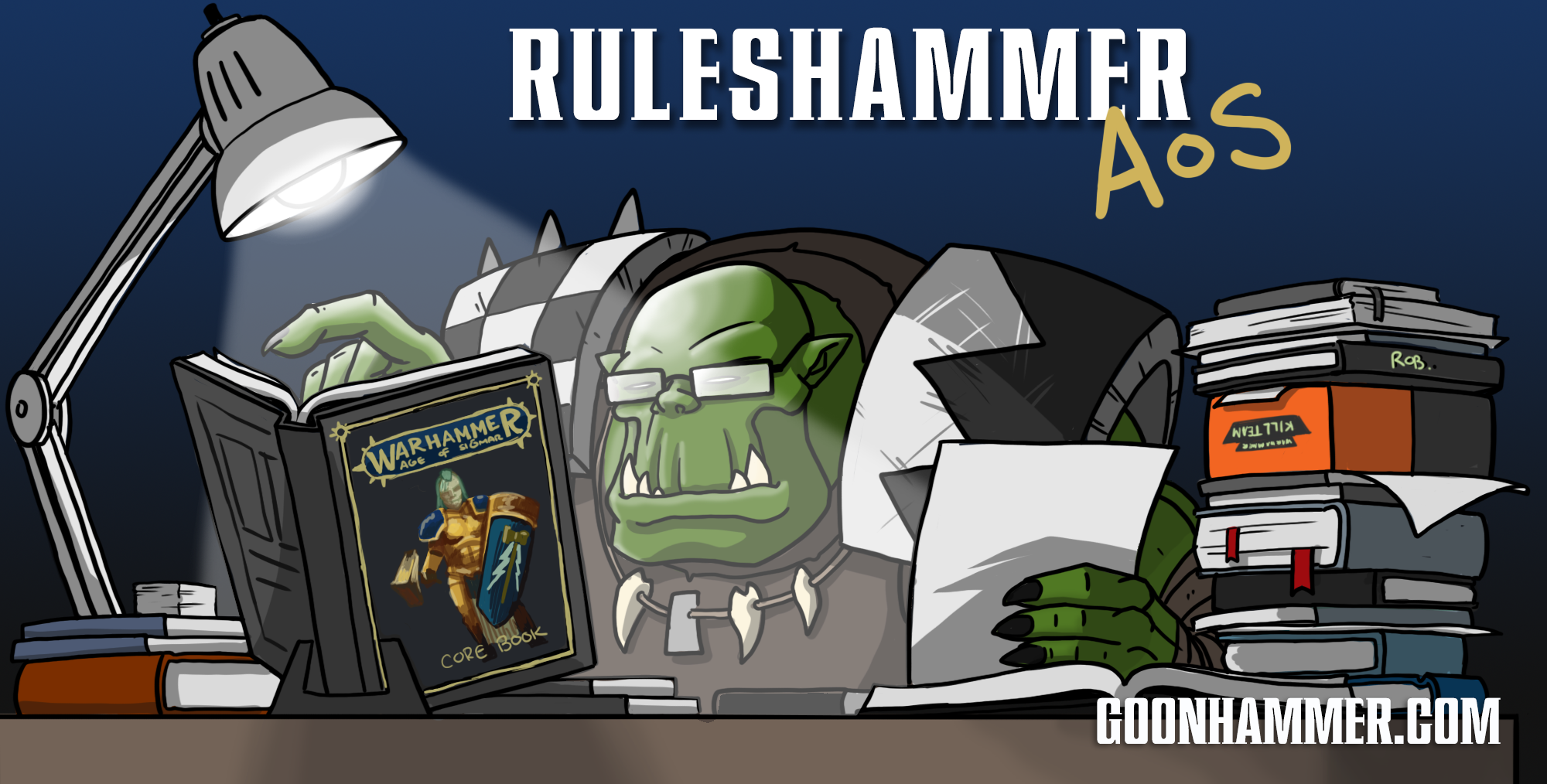Hey everybody! Alice here, Rob “Vre’kias” Chilton needed some time to rest his brain from all your tough questions so I thought I’d step up and offer some of my own guidance. This week I’m going to focus on my area of expertise, Age of Sigmar. We get our fair share of questions regarding rules discrepancies there too so I’m going to try and pick out some of the more common ones I see.
One of the first things we covered for 40k was the language used around “within” by Games Workshop and while there are still some important distinctions for that language in Age of Sigmar, the rules here aren’t nearly as needlessly complicated.
“Wholly Within” vs. “Within”?
Many spells and abilities in the game will define their range as affecting units or models that are either “Wholly Within” or “Within” a certain number of inches of the caster, from prayers of the Battletome for Stormcast Eternals:
Celestial Blades: If successfully cast, pick a friendly STORMCAST ETERNAL unit wholly within 18″ of the caster that is visible to them. Add 1 to wound rolls for attacks made with that unit’s melee weapons until your next hero phase.
To spells for Disciples of Tzeentch:
Bolt of Tzeentch: If successfully cast, pick 1 enemy unit within 18″ of the caster and visible to them. That unit suffers D6 mortal wounds.
To a beginner the distinction might seem a little arbitrary, but in game terms this small distinction is crucial. In short, “Wholly Within” means that every part of a model’s base must be within the specified range, and for units that means the entire unit must be within that range (In the case of Celestial Blades above, 18″). “Within” just means that the smallest bit of a model or a single model in a unit manages to get into your effect range. This is covered in the Age of Sigmar Designer’s Commentary, Page 3:
Q: Sometimes a rule will specify that a model or unit needs to be ‘wholly within’ a certain distance. What exactly does ‘wholly
within’ mean?
A: A model is wholly within a certain distance if every part of its base is within the stated distance. A unit wholly within a certain distance if every part of the bases of all of the models in the unit is within the stated distance.
He’res a handy diagram you an use to help visualize the difference:

Thankfully, it’s gotten easier to remember this. Most of the time, Battletomes post-Soul Wars have helped keep ruling consistent: If it’s meant to target an ally then you’ll typically find that the effect requires affected units be wholly within. If it targets an enemy it’s likely to require they be merely within. If you have an older Battletome that’s still in use, be sure to double check but you can pretty consistently rely on this to be the case.
While we’re on the subject. Cover is based on wholly within:
COVER – Add 1 to save rolls for a unit if all of its models are wholly on or within a terrain feature when the rolls are made.
This is of particular note because Rules as Written you’re supposed to be rolling each attack one at a time, we just rarely do that because it would take all day. If you ever find yourself in a situation where some of your units are behind cover and some aren’t, you will want to ask your opponent to roll one at a time since once the models that are not in cover are dead, the unit is now “Wholly” within cover and therefore benefits.
Dual Wielding Instruments and Banners
Due to being leftovers from Warhammer Fantasy Battles, many units in Age of Sigmar have access to banners and instruments that buff the whole unit. These are free bonuses; they don’t cost any points and taking them doesn’t deprive them of a weapon, so there’s no reason not to include them. Additionally, there are often more powerful variants within a unit, such as a sergeant who operates off a similar principle. As an example let’s look at the Pink Horrors:
IRIDESCENT HORROR: 1 Pink Horror model in this unit can be an Iridescent Horror. […]
ICON BEARER: 1 in every 10 Pink Horror models in this unit can be a Pink Horror Icon Bearer. […]
HORNBLOWER: 1 in every 10 Pink Horror models in this unit can be a Pink Horror Hornblower.
A question I get a lot is: “Is it possible to say, put the Icon and Hornblower on the same model?” It makes sense, if you had them on the same models, you could make sure they were the last model to die off and therefore never lose their bonuses. The answer is usually no, because of the wording on the unit – you don’t give a Pink Horror an icon, you replace one Pink Horror with a Pink Horror Icon Bearer, with that specific title. Since that model is no longer a Pink Horror, you can no longer upgrade him to be a Pink Horror Hornblower. Note that this isn’t always true though, and depends on specific wording – right in the same book, Tzaangors can contradict this:
TWISTBRAY: 1 model in this unit can be a Twistbray. Add 1 to hit rolls for attacks made with that model’s melee weapons.
TZAANGOR MUTANT: 1 in every 5 models in this unit can be a Tzaangor Mutant armed with a pair of Savage Blades and a Vicious Beak.
ICON BEARER: 1 in every 10 models in this unit can be an Icon Bearer. A unit that includes any Icon Bearers can use the OrnateTotems ability.
BRAYHORN: 1 in every 10 models in this unit can have a Brayhorn. A unit that includes any Brayhorns can run and still charge later in the same turn.
Note the difference here: Brayhorns do not say “can be a Brayhorn”, it says they can have one. Which means if you want to you can put the Brayhorn on any model, since it doesn’t say it changes the name of the model itself. Is this going to make a huge difference in games? Probably not, if you’re down to the last 2 models in a unit they’re probably done for anyway, but it’s a question I get a lot nonetheless so I was hoping to shed some light on it.
Saves vs. Feel No Pain
This is a more beginner question, but it trips a lot of new players up. For context a “Feel No Pain” save is a slang term for abilities that allow you to roll to ignore wounds after you’ve failed a saving throw (Disgustingly Resilient on Plaguebearers is a common example). Unlike a Saving throw, these aren’t on every character – It’s often a special ability granted by certain command abilities, relics or spells. As an example, let’s check out the Great Unclean One, star of the Maggotkin of Nurgle, among whom these abilities are common:
Blubber and Bile: Roll a dice each time you allocate a wound or mortal wound to this model. On a 5+ the wound is negated.
Allocating a wound is done after you fail a save. A Great Unclean One has a save of 4+, so lets say your opponent hits him with a painful Damage 3 weapon. You roll one armor save, and get a 3, failing. So now you allocate 3 wounds onto him. This is where the Blubber and Bile comes in. Now instead of rolling 1 die for the attack, you’re rolling one die for each point of damage. So you roll 3 dice, get a 5, 6 and a 2. Since two of those results were a 5+, they’re negated and thanks to Blubber and Bile the attack only does one damage. Our Great Unclean One remains a happy boy indeed.
So in short:
- Opponent Hits and Wounds.
- You roll one save per attack
- If that fails, roll one die per point of damage for the Feel No Pain.
References
To answer these questions I referred to:
The Age of Sigmar Core Rules – https://www.games-workshop.com/en-GB/AoSSW-Core-Rules-PDF-2018-ENG
Designer’s Commentary – https://www.warhammer-community.com/wp-content/uploads/2019/07/8f9bd00c.pdf
Various Battletomes
Wrapping Up
That’s it for this week. Pretty basic questions this time, but I’d like to know more about what rules are stumping you. Post some of your Age of Sigmar related questions over on the Ruleshammer subreddit or email them to us at contact@goonhammer.com and you might see them here. Till next time!


